1970 Tasmania v Western Australia
Game description
Teams
B: Kayden Edwards, Paul Vinar, Max Urquhart.
HB: John Jillard, Anthony Thiessen, Ricky Graham.
C: Stan Dac, Roger Steele, Rodney Stirling.
HF: John Bingley, Darrel Baldock, Ron Hall.
F: Lance Styles, Athol Hodgetts, John Marshall.
R: Jim Frost, John Devine, John Bonney.
Int: Adrian Bowden, Ray Johnson.
Coach: John Devine.
B: Alan Styles, Graham Reilly, Ian Cooper.
HB: Trevor Sprigg, Bob Shields, Len Clark.
C: Greg Brehaut, Peter Manning, George Young.
HF: Stephen Smeath, Mal Brown, Peter Metropolis.
F: Peter Burton, Lindsay Carroll, Bruce Duperouzel.
R: Graham Farmer, Bill Dempsey, Bill Walker.
Int: Bob Page, Cam Blakemore.
Coach: Graham Farmer.
Gallery
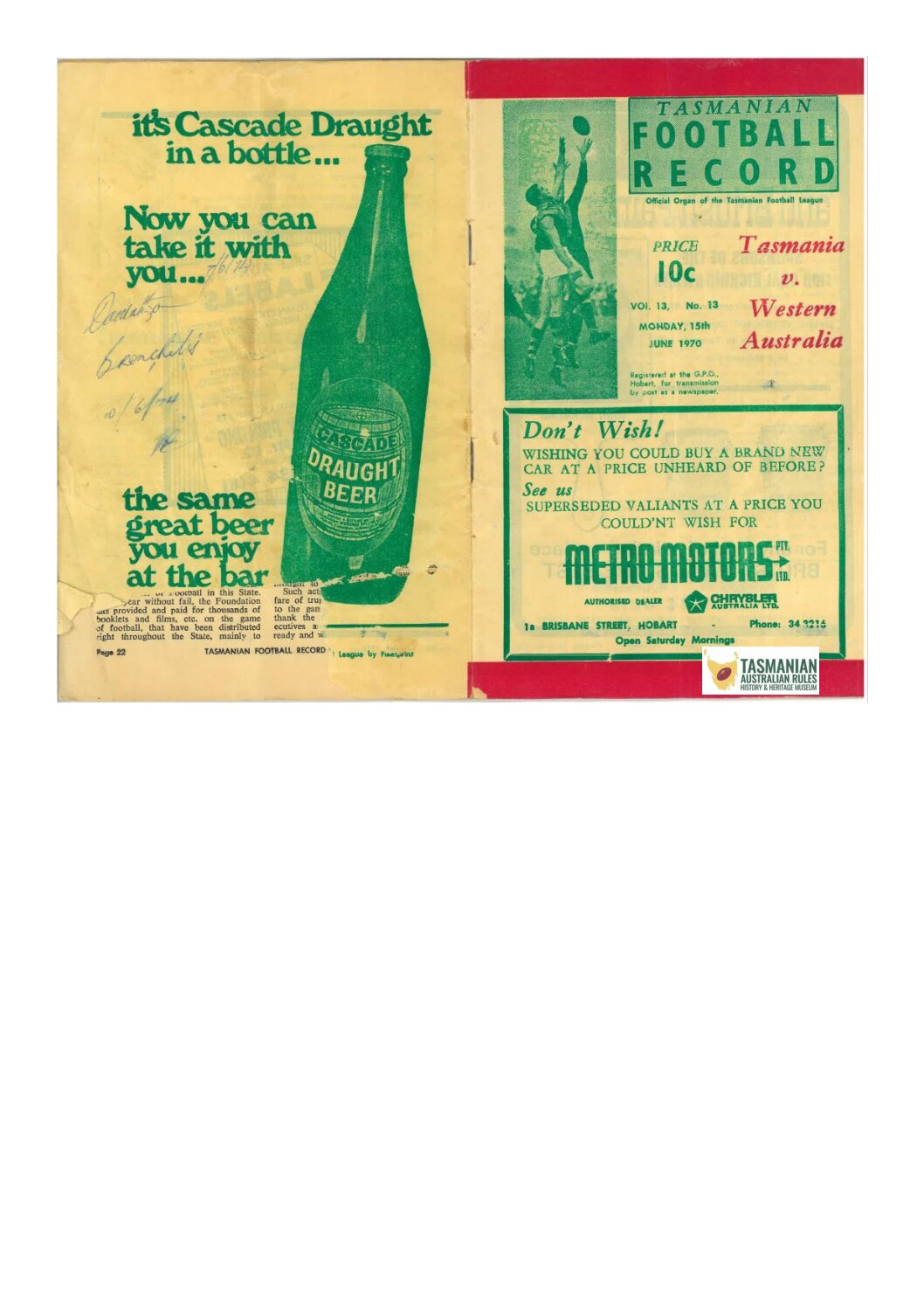
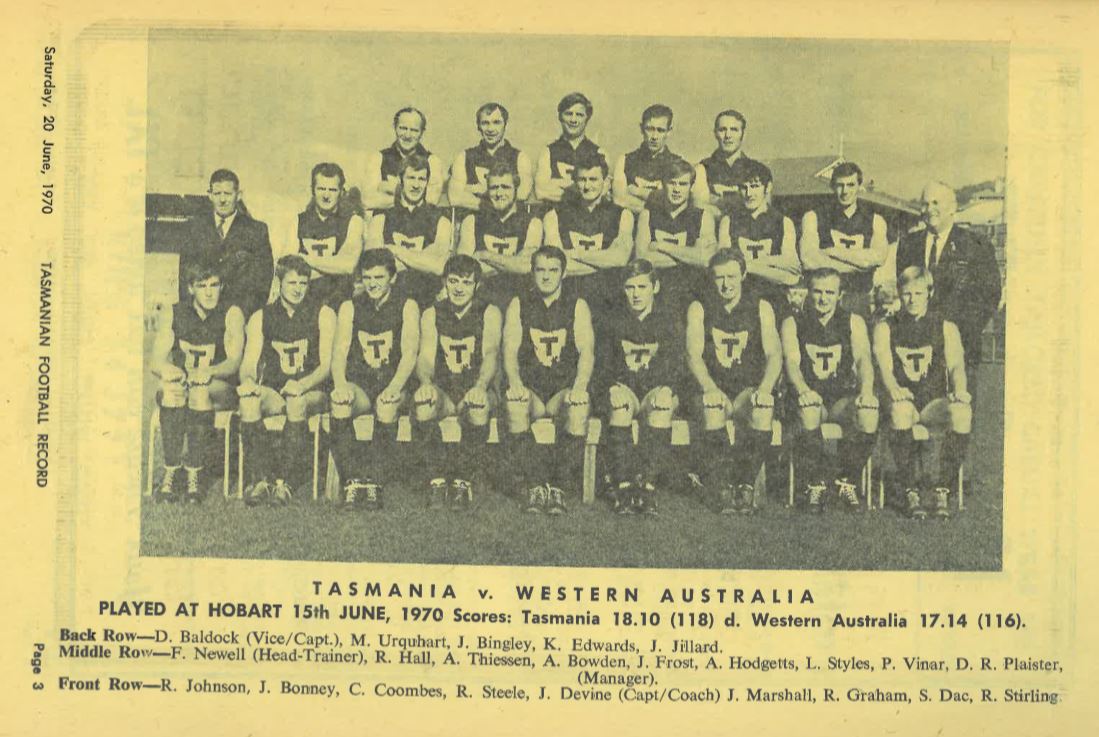
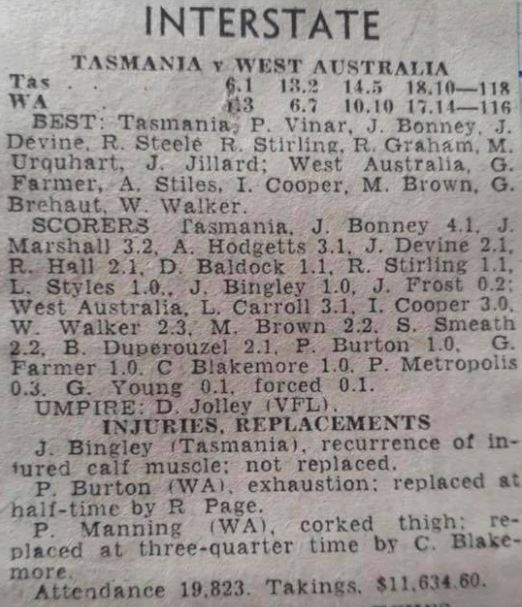
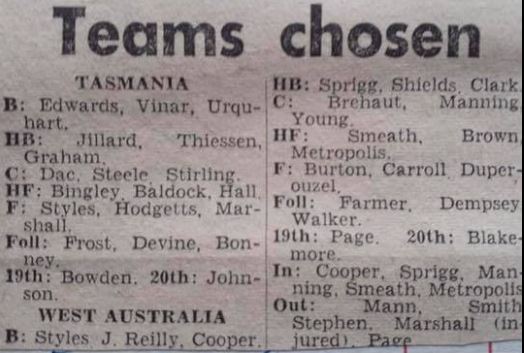
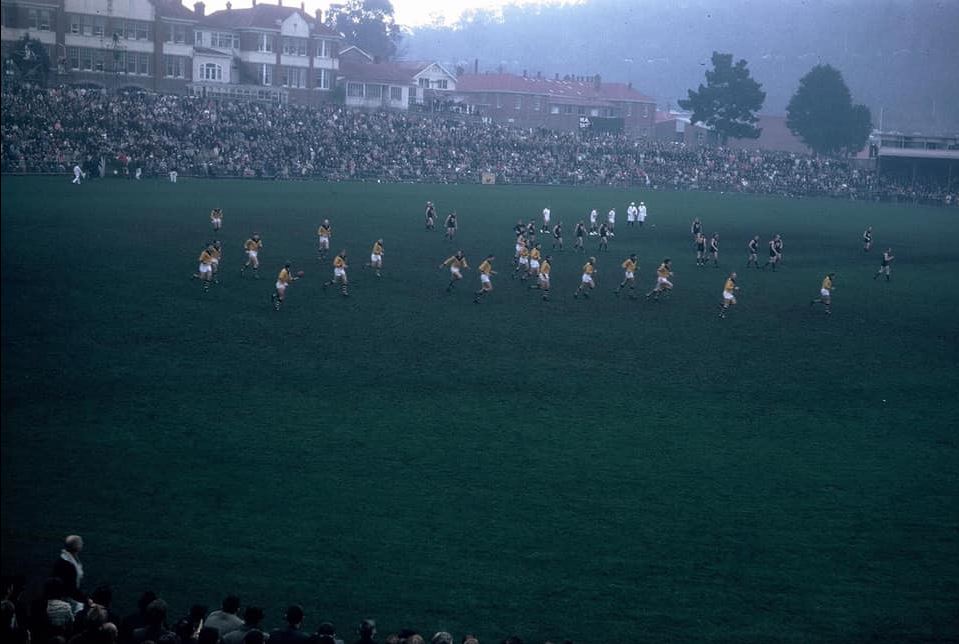
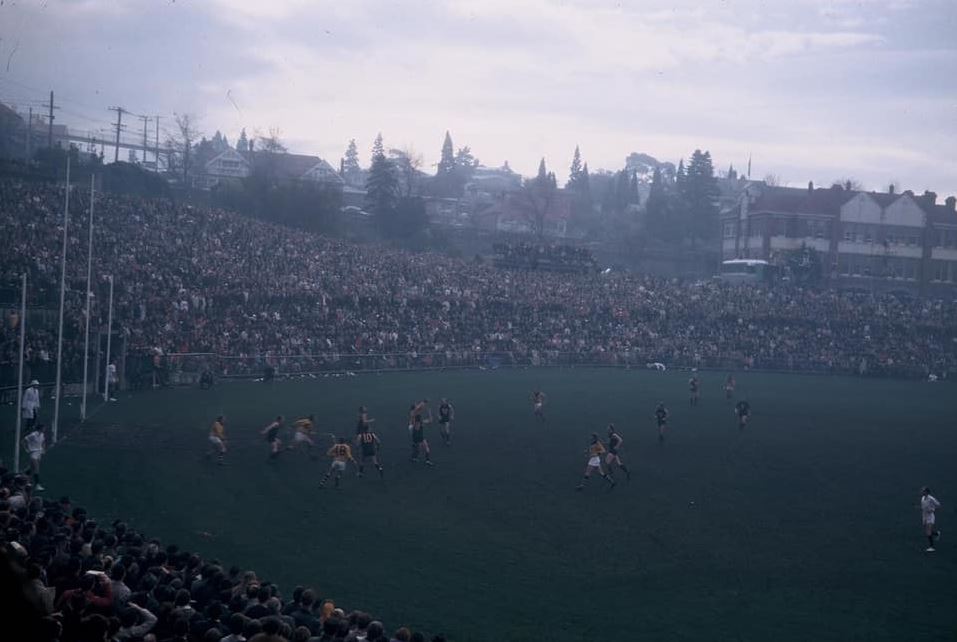
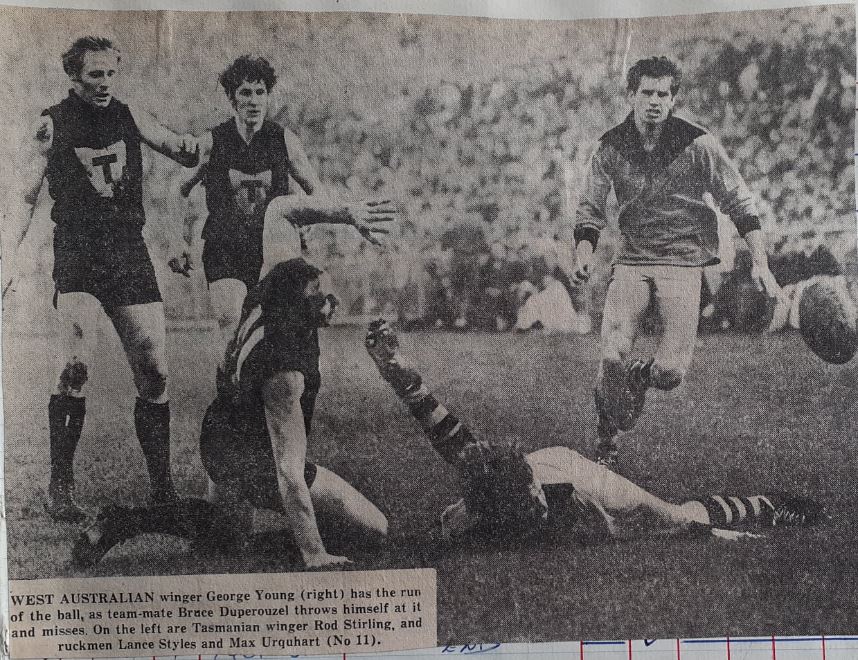
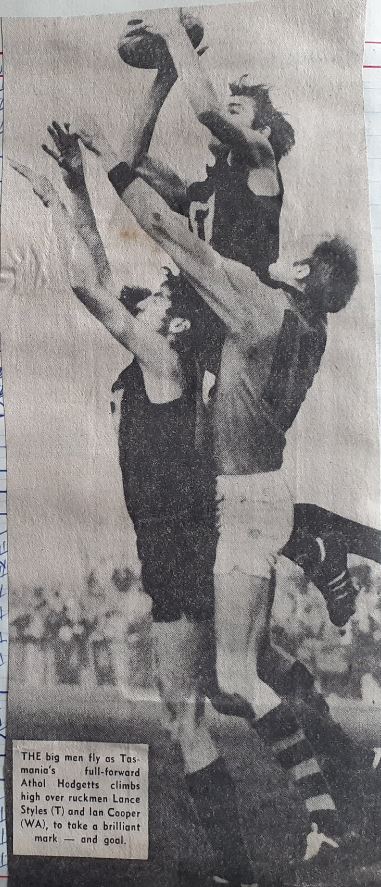
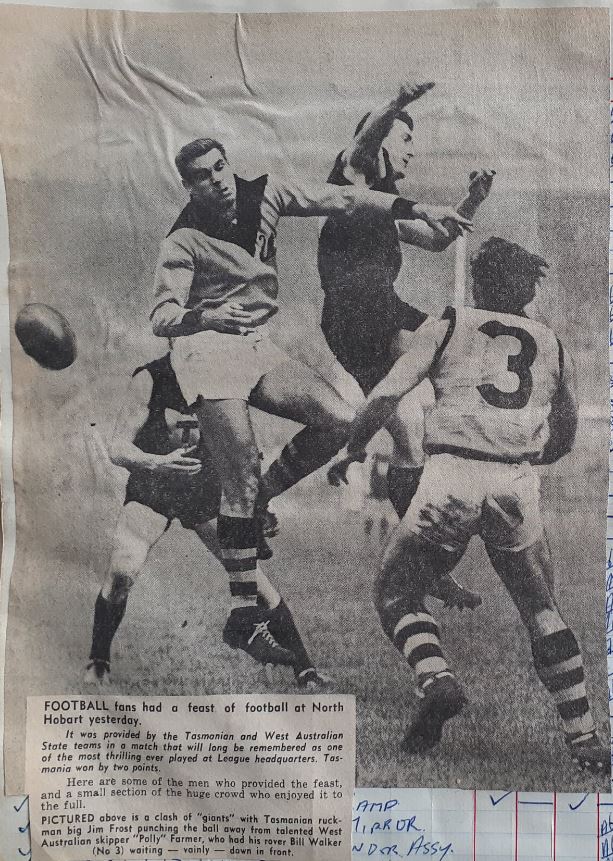
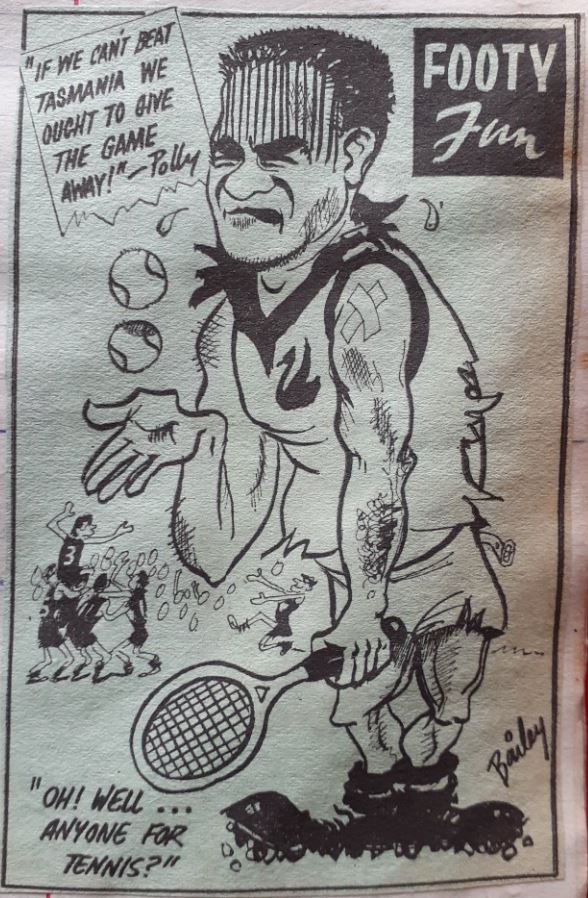

Articles
STATE COULD GIVE WEST RUN FOR MONEY by Keith Welsh (15/06/1970)
The West Australians arrived in Hobart yesterday “bruised, bloodied but unbowed” after their gallant near-defeat of the VFL in Melbourne on Saturday.
And it is largely because of the VFL’s softening-up of the visitors that Tasmania all spelled from club games on Saturday, must be conceded a good chance of lowering West’s colours at North Hobart today.
Five West Australians were unable to train yesterday. Vice-captain Dennis Marshall and Peter Stephen have injured knees. Hassa Mann a back injury, Bradley Smith a bruised thigh and full-back Graham Reilly pulled a thigh muscle at training in Melbourne on Friday.
The selectors last night had only the bare 20 from which to choose today’s team.
Tasmanian captain-coach John Devine is likely to instruct his players to go in hard early on the score that the West Australians will not appreciate fierce tackling after the hard game against Victoria.
Tasmanians have had a reputation of hanging out but when they met the VFL here in 1967 they were primed to tackle the Victorians hard and it paid dividends.
Whereas West Australia had only 20 players from whom to make their choice. Tasmanian selectors had to decide only which player to drop from the 21 and then name the positions.
Coombes of the NTFA was the unlucky player and the placings were those named in ‘The Mercury’ on Saturday.
West Australia will have a big advantage on the ruck. Farmer (6ft 3in) and Dempsey (6ft 2in) will open in the first ruck with the brilliant Bill Walker roving and the tallest man afield Peter Burton, who is (6ft 6in) will partner former St Kilda follower Ian Cooper in the second ruck with Bruce Duperouzel rover.
Each of these may be too strong for the Tasmanian following divisions, although Bonney and Marshall should do well around the packs. Ruck-rovers John Devine and John Bingley also are expected to do well.
Roger Steele is the finest pivot in Tasmania and is the springboard for many attacks.
The West Australians deserve their high reputation especially after getting within six points of Victoria.
“We won everything except on the board,” the WAFL president (Mr Ken Miller) said yesterday.
But more than half the Tasmanian side have had VFL experience and several of the others are being sought by Melbourne clubs so the home side will not be over-awed by reputations.
Tasmania look the faster side and if they can keep the ball low and rely on their pace they could worry the taller West Australians.
It should be a great game and although West Australia will start favourites Tasmania can take the honours if they tackle fiercely, exploit their pace and go flat out for their State.
WHAT A WIN! Tasmania back in business, by Keith Welsh 16th June 1970
A 40 yard goal by John Bingley within 30 seconds on the final siren enabled Tasmania to snatch a two-point victory from the fast finishing West Australian side at North Hobart yesterday.
It was one of the most thrilling matches ever in Tasmania and the standard of play was high as all-times.
Tasmania led throughout until a minute and a half of the time-on period when West’s Mal Brown marked and booted their 17th goal.
Tasmania, who at one stage in the second quarter led by 49 points with the scores at 12.2 to 3.7 had seen their margin gradually whittled down in the third and last quarter until they trailed by four points and appeared to have lost.
But at this stage captain John Devine rallied his forces, Marshall snapped a single and then with less than a minute of play remaining Vinar, Stirling, Devine and Baldock got the ball to Bingley who marked low down.
The crowd waited hopefully but not confidently as Bingley, limping badly from a recurrence of a calf injury went back to take his kick.
An earlier effort had not been accurate but this time his shot from 40yds out between a forward pocket and a flank sailed right through the centre and Tasmania were in front again.
The crowd of 19,823 all but a few of them Tasmanian supporters, yelled themselves hoarse as West Australia stormed forward but Latrobe and former Footscray defender John Jillard intercepted and knocked the ball in front of him as the siren sounded.
It was the first time that Tasmania had ever defeated West Australia on Tasmanian soil and only the fourth time that they had ever lowered West’s colours in nearly 60 years.
The crowd went wild with delight. Thousands jumped the boundary fence and mobbed their heroes in the greatest ovation ever accorded a football team at North Hobart.
Tasmania were well on top in the centre where Roger Steele carried too many guns for Peter Manning. But West had the early call on George Young’s wing in the first half only to see Rod Stirling take the initiative and outpace him in the second half.
Brehaut was a winner for West Australia on the other wing, although Stan Dac did many fine things for Tasmania.
It was only when Manning left the field at three-quarter time and Cam Blakemore replaced him that West Australia gained some drive from the centre – a drive which all but succeeded in carrying the visitors to victory.
Although Tasmania’s accuracy for goal masterly great credit also must be given the her defenders.
Paul VInar at full back was Tasmania’s best man.
He outmaneuvered Lindsay Carroll and out marked him for three quarters and when Brown was moved to the sticks in the last quarter – a move which West Australia might profitably have made much earlier – Vinar limited him to one goal.
At the other end of the field Darrel Baldock showed glimpses of his artistry and continually drove forward. BUt he was nearly always under pressure and held only two marks.
Ron Hall on a half-forward-flank turned in his best interstate performance and the longer he played the more confident did he play. He scored two goals and ws responsible for several others and during the last quarter he took over the centre half-forward berth.
That was a winning move made by Devine, Baldock going into the centre when Blakemore had gained the upper hand of Steele and the Sandy Bay pivot going to a flank.
Tasmania’s pace and fierce tackling worried the visitors who found themselves trailing 1.3 to 6.1 at the end of the first term and 6.7 to 13.2 at half time.
It was after Tasmania had scored their 14th goal in the third term that West Auatralia began fighting desperately – and successfully – to get back into the game.
Their rucks were now on fill command. Brown was dominant at centre half-forward, Walker at last was winning around the packs and the West’s teamwork began to click.
At the final change, Tasmania’s lead had been whittled down to 19 points.
When Cooper goaled within 30 seconds of the opening of the final term the partisan crowd began to have misgivings. But they soon were jumping joyfully as a single by Baldock was followed by goals by Hall and Bonney and another single by Hall put Tasmania 27 points in front.
The rucking of Farmer and Bill Dempsey was too strong for Jim Frost and lance Styles but Tasmanian ruck-rovers Devine and Bingley were supreme and in the first half particularly rovers John Bonney and John Marshall were in command around the packs.
Again West Australia applied the pressure driving wide to the flanks where their men were unattended by the tiring Tasmanians.
Carroll, Brown, Walker and Brown again added goals and one and a half minutes into the time-on period West Australia were four points in front.
Bingley marking near centre half-forward from Dac, drove forward. Frost just failed to mark and on the scrimmage Marshall scored a single. But Brown immediately equalised.
The seconds were ticking off and Tasmania appeared to have done their dash especially as West drove forward again.
But the ever-reliable Vinar was in the way and when Bingley sent the ball right through the sticks to put Tasmania two points in front the home side had triumphed.
Tasmanian football prestige had been restored.
Tasmania deserved their victory.
Seldom has a Tasmanian side showed such determination and will to win. They matched the visitors vigour in every respect and outpaced them in the first half.
Tasmania’s pace was a telling factor and they invariably won the race to the ball. They also were able to nullify West’s aerial strength with spoiling tactics.
But West Australia left Tasmania for dead in the use of effective handball and the inspiration came from the old master himself “Polly” Farmer.
Tasmania received more than half as many free kicks again as West Australia, but the breaches in both sides were detected and promptly penalised. Umpire Don Jolly of the VFL gave an excellent display.
Knowledgeable football followers had expected Tasmania to win, principally on the score that West Australia would be both sore and tired after their match in Melbourne on Saturday, when they went down by six points to the VFL.
But surprisingly West finished the stronger. However, the buffeting they received in the Victorian match may have accounted for the slowness on the visitors in the first half.
‘Dead-eye’ dobbed it by Keith Welsh
What were the feelings of the 19,800 people at the North Hobart ground on Monday when 30 seconds from the final siren, John Bingley marked on an angle just 40 yards from goal?
It would be idle to say they were confident.
Perhaps no one was less confident than “The Count” himself because he is anything but the most accurate kick in the South.
In fact, his accuracy when shooting for goal is well known.
In the 3 ½ seasons with Clarence, he has kicked only 26 goals – 11 in 1967, six in 1968, two last year and seven this year.
But in fairness to the Clarence coach it must be said that he has played mostly in defence.
However, when he has gone into the ruck or been in a position to score, accuracy has not been his strong point.
But Bingley, who had been off the target earlier in the match against the Sandgropers, realised that the fate of Tasmania rested firmly on his shoulders.
A goal would put Tasmanis in front; anything less less would almost certainly sound the death-knell.
“Dead-eye” Bingley was the man for the job. His punt went right through the centre to put Tasmania two points in front and half a minute later the siren sounded with the State victorious and Bingley a hero.
Article: Lefroy medal to Paul Vinar by Keith Welsh (Photo: 1970 Lefroy Medal to Paul Vinar in photos list)
State full-back Paul Vinar, of Longford has won the Lefroy Medal for the best and fairest Tasmanian player of the year.
He was the unanimous choice of all the four selectors.
Rover John Bingley of Cooee, was second with six votes, receiving the second vote of three selectors.
Third placing went to another rover, John Marshall (North Hobart). Although Marshall played well it was not thought generally that he would have polled ahead of State and North Hobart captain John Devine.
Four players each received one vote – Devine, Wynyard coach Max Urquhart, Clarence winger Rod Stirling and Ulverstone follower Jim Frost, whose inclusion in the voting was a surprise.
Vinar’s success is well deserved. He kept West Australian full-forward Lindsay Carroll down to three goals and throughout was an attacking full-back.
He won 18 field kicks in addition to kicking off 14 times, he held eight marks and two of his kicks went to the centre of the ground.
With his last kick he initiated the move which carried the ball from full-back along the wing through Stirling, Devine to Bingley, who kicked the goal to bring Tasmania victory.
Vinar (29, 6ft 2in, and 13.4) played 145 games for Geelong before his appointment as coach of Longford in 1967.
The holder of the Australian drop-kick record in 1965, Vinar also represented Tasmania at the ANFC championships in Adelaide last season.